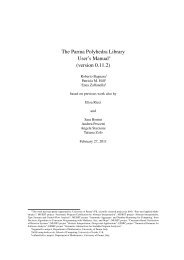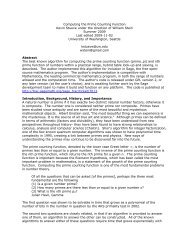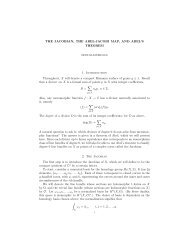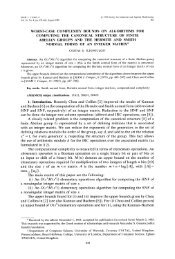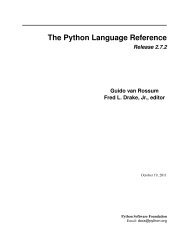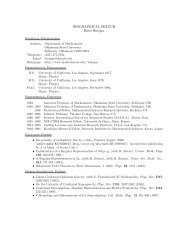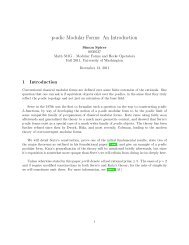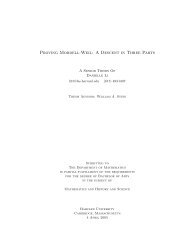Efficient implementation of the Hardy-Ramanujan ... - William Stein
Efficient implementation of the Hardy-Ramanujan ... - William Stein
Efficient implementation of the Hardy-Ramanujan ... - William Stein
Create successful ePaper yourself
Turn your PDF publications into a flip-book with our unique Google optimized e-Paper software.
IMPLEMENTATION OF THE HRR FORMULA Page 13 <strong>of</strong> 19<br />
Since our <strong>implementation</strong> presently relies on some numerical heuristics (and in any case,<br />
considering<strong>the</strong>intricacy<strong>of</strong><strong>the</strong>algorithm),carehasbeentakentotestitextensively.Alln ≤ 10 6<br />
have been checked explicitly, and a large number <strong>of</strong> isolated n ≫ 10 6 have been compared<br />
against known congruences and values computed with Sage and Ma<strong>the</strong>matica.<br />
As a strong robustness check, we observe experimentally that <strong>the</strong> numerical error in <strong>the</strong> final<br />
sumdecreaseswithlargern.Forexample,<strong>the</strong>errorisconsistentlysmallerthan10 −3 forn > 10 6<br />
and smaller than 10 −4 for n > 10 9 . This phenomenon reflects <strong>the</strong> fact that (1.8) overshoots<br />
<strong>the</strong> actual magnitude <strong>of</strong> <strong>the</strong> terms with large k, combined with <strong>the</strong> fact that rounding errors<br />
average out pseudorandomly ra<strong>the</strong>r than approaching worst-case bounds.<br />
4. Benchmarks<br />
Table 1 and Figure 1 compare performance <strong>of</strong> Ma<strong>the</strong>matica 7, Sage 4.7 and FLINT on a<br />
laptop with a Pentium T4400 2.2 GHz CPU and 3 GiB <strong>of</strong> RAM, running 64-bit Linux. To <strong>the</strong><br />
author’s knowledge, Ma<strong>the</strong>matica and Sage contain <strong>the</strong> fastest previously available partition<br />
function <strong>implementation</strong>s by far.<br />
The FLINT code was run with MPIR version 2.4.0 and MPFR version 3.0.1. Since Sage 4.7<br />
usesanolderversion<strong>of</strong>MPIRandMa<strong>the</strong>maticaisbasedonanolderversion<strong>of</strong>GMP,differences<br />
in performance <strong>of</strong> <strong>the</strong> underlying arithmetic slightly skew <strong>the</strong> comparison, but probably not<br />
by more than a factor two.<br />
The limited memory <strong>of</strong> <strong>the</strong> aforementioned laptop restricted <strong>the</strong> range <strong>of</strong> feasible n to<br />
approximately 10 16 . Using a system with an AMD Opteron 6174 processor and 256 GiB RAM<br />
allowed calculating p(10 17 ), p(10 18 ) and p(10 19 ) as well. The last computation took just less<br />
than 100 hours and used more than 150 GiB <strong>of</strong> memory, producing a result with over 11 billion<br />
bits. Some large values <strong>of</strong> p(n) are listed in Table 2.<br />
AscanbeseeninTable1andFigure1,<strong>the</strong>FLINT<strong>implementation</strong>exhibitsatimecomplexity<br />
only slightly higher than O(n 1/2 ), with a comparatively small constant factor. The Sage<br />
n Ma<strong>the</strong>matica 7 Sage 4.7 FLINT Initial<br />
10 4 69 ms 1 ms 0.20 ms<br />
10 5 250 ms 5.4 ms 0.80 ms<br />
10 6 590 ms 41 ms 2.74 ms<br />
10 7 2.4 s 0.38 s 0.010 s<br />
10 8 11 s 3.8 s 0.041 s<br />
10 9 67 s 42 s 0.21 s 43%<br />
10 10 340 s 0.88 s 53%<br />
10 11 2,116 s 5.1 s 48%<br />
10 12 10,660 s 20 s 49%<br />
10 13 88 s 48%<br />
10 14 448 s 47%<br />
10 15 2,024 s 39%<br />
10 16 6,941 s 45%<br />
10 17 27,196* s 33%<br />
10 18 87,223* s 38%<br />
10 19 350,172* s 39%<br />
Table 1. Timings for computing p(n) in Ma<strong>the</strong>matica 7, Sage 4.7 and FLINT up to<br />
n = 10 16 on <strong>the</strong> same system, as well as FLINT timings for n = 10 17 to 10 19 (*) done on<br />
different (slightly faster) hardware. Calculations running less than one second were repeated,<br />
allowing benefits from data caching. The rightmost column shows <strong>the</strong> amount <strong>of</strong> time in <strong>the</strong><br />
FLINT <strong>implementation</strong> spent computing <strong>the</strong> first term.



